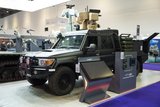Northrop Grumman and US Army complete another phase of testing of the Common SIGINT System
Northrop Grumman Corporation and the US Army recently completed another phase of testing of the Common Signals Intelligence (SIGINT) System 1500 (CSS-1500), validating several key functions of the system including instantaneous geolocation, Irregular Warfare (IW) signal exploitation, and SIGINT battlespace situational awareness.
The CSS-1500 is Northrop Grumman's next generation of small scale, lightweight SIGINT payloads and is a segment of the company's Airborne SIGINT Product Line (APL). The testing, part of a Cooperative Research and Development Agreement (CRADA), was conducted by the US Army to gather data on the capability of the payload and enable data analysis against other payloads.
"These tests further validate the primary capabilities of the CSS-1500," noted Trip Carter, director of Airborne Intelligence, Surveillance, and Reconnaissance (AISR) for Northrop Grumman. "The test validated the CSS-1500's Instantaneous Geolocation Arrow capability, which allows the sensor to locate targets with a high degree of accuracy in a matter of seconds."
"Northrop Grumman's CSS-1500 system is ready to be integrated onto existing and emerging AISR platforms," said Carter. "This capability will bring our troops vital information about the enemies they are facing today and enable better utilization of other assets, such as full-motion video. This is a game-changing technology that surpasses currently-fielded or even planned SIGINT systems."
Source: Northrop Grumman
Follow Shephard News on Twitter
More from Digital Battlespace
-
![Babcock nears first customer for Nomad AI translation tool]()
Babcock nears first customer for Nomad AI translation tool
Nomad can provide militaries with real-time intelligence, saving critical time on the battlefield.
-
![AUSA 2025: Israel’s Asio Technologies to supply hundreds of improved Taurus tactical systems]()
AUSA 2025: Israel’s Asio Technologies to supply hundreds of improved Taurus tactical systems
Taurus operates alongside the Israel Defense Forces’ Orion system which supports mission management across tens of thousands of manoeuvring forces, from squad leaders to battalion commanders.
-
![AUSA 2025: Kopin pushes micro-LED plans as China moves faster]()
AUSA 2025: Kopin pushes micro-LED plans as China moves faster
The plan for the new displays follows fresh investment in Kopin’s European facilities by Theon and an order for head-up displays in fielded aircraft, with funding from the US Department of Defense.
-
![AUSA 2025: Persistent Systems to complete its largest order by year’s end]()
AUSA 2025: Persistent Systems to complete its largest order by year’s end
Persistent Systems received its largest ever single order for its MPU5 devices and other systems earlier this month and has already delivered the 50 units to the US Army’s 4th Infantry Division.
-
![Aselsan brings in dozens of companies and systems under the Steel Dome umbrella]()
Aselsan brings in dozens of companies and systems under the Steel Dome umbrella
Turkey has joined the family of countries attempting to establish a multilayered air defence system with government approval in August 2024 for the effort landed by Aselsan. Dubbed Steel Dome, the programme joins Israel’s Iron Dome, the US Golden Dome, India’s Mission Sudarshan Chakra and South Korea’s low-altitude missile defence system.
-
![DSEI 2025: MARSS unveils new agnostic multidomain C4 system]()
DSEI 2025: MARSS unveils new agnostic multidomain C4 system
MARSS’ NiDAR system has been deployed using sensors from static platforms to provide detection and protection for static sights, such as critical infrastructure, ports and military bases.




























